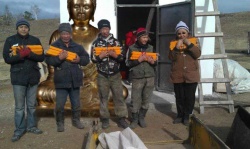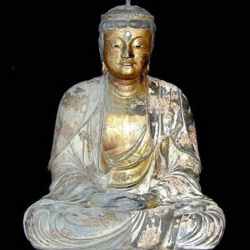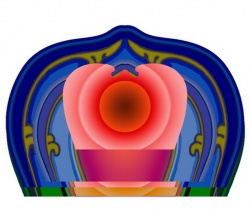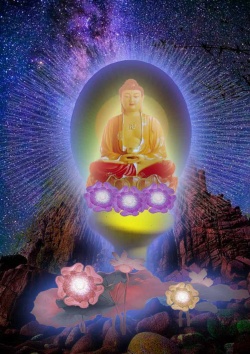Unfamiliar ground of Tibetan mystery
Perhaps it is time to admit that there is a limit to our attempts at making every culture in the world accessible to all others.
The "Demonic Divine: Himalayan Art and Beyond" show, which runs at the new Rubin Museum of Art here until Jan. 9, deals with a key aspect of Tibetan art, the wrathful deities who, the Buddhist monk Matthieu Ricard writes in a foreword, are "the focus of so many contemplative practices in Tibet." Their terrifying appearance, we are told, "expresses the invincible power of compassion."
The exhibition is impressive at first glance. It draws on the collections formed by an enthusiastic New York couple, Donald and Shelley Rubin, who donated some of their belongings while retaining others (shown on loan), and on loans from other sources.
But few Western visitors gazing at the very first image will feel on familiar ground. Introduced as "Durtro Lhamo, Protectress [sic] of Discovered Texts," it is described a few lines down as "Durtro Lhamo, the Goddess of the Charnel Grounds." The learned writer helpfully goes on: "She is also known as Drogzema, the Powerful [[[Wikipedia:female|female]]] Friend." Eager to clarify matters, the author adds: "Durtro Lhamo is intimately involved with terna, which are the 'treasure texts' miraculously discovered in rocks or pillars by teachers with special insights," etc., etc.
These are excerpts from the lighter passages of a long entry. Readers who are not Tibetologists are unlikely to go beyond the first lines of the commentary. Outsiders soon lose their footing in this accumulation of unfamiliar names and notions. The authors are not to be blamed. If they are to say anything, there is no alternative to mentioning names and concepts that are central to the faith.
As a result, viewers who are induced by a compelling or intriguing image to glean basic information feel like first-year students struggling with the handbook of an arcane discipline.
The frustration is the greater when some paintings have an instant appeal. To a novice, the "Red Wolf-headed Protectress" displays an irresistible sense of burlesque. In this 19th-century painting on cotton, a human-like creature with the head of a wolf dressed in blazing red rides on the back of a white bird of prey, perhaps an eagle. Both roll their eyes as in some slapstick comedy. Behind the werewolf-like creature and its winged steed, more eagles stare with the same goggle-eyes. Festooned clouds arranged in staggered rows fill the background. The image is a lark.
The accompanying text meant to throw light on this painting and a companion image is not quite so entertaining:
"These two paintings were once part of a set of at least nine paintings centered on Shanglon Gonpo (Minister Mahakala). Collectively, they are the protectors of the four medical tantras and derive from the visions or revelations (nyingtig, 'heart essence') of Yutog Yontan Gonpo (790-1015). The set itself must have been a subset within a larger group, since a third related painting depicts one of the five forms of Pehar, with Yutog Yontan Gonpo."
The description goes on in long columns without room enough to break up the dense discourse into paragraphs. If you look for an explanation to the 225-year span you are requested in a footnote to "see TBRC item P4333," followed by information equally impenetrable to nonspecialists.
Aimed at academics, this prose leaves most spectators at sea. When it comes to marvelous fragments from manuscripts, it does not get any more gracious or helpful. A long horizontal leaf on once dark blue paper, now almost black, carries six lines of magnificent calligraphy. The dancing rhythm of the lettering, all curves and spikes, is fascinating. One wonders whether there is a link between the vibrancy of these characters and the textual context.
At each extremity, two images flank the long horizontal block of text. They are powerful and intriguing. One is a standing male figure, one leg flexed, raising an arm as it presses an object with tremendous energy. The tiger skin used as a loincloth and the rippling muscles of the blue-colored body suggest invincible strength. The blazing red background with dancing flames delicately indicated by an artist using the tip of a fine brush enhance the impression of power unleashed.
At the other end, another male figure straddles a white "snow lion" against a similar ground. The short caption identifies the first image as "Vajrapani, Vajra Holder" (without bothering to specify that the vajra is a bronze instrument) and the other image as "Vaishravani, King of the North Direction."
Intrepid explorers of cultures other than their own who may seek enlightenment in the long entry, discover that, irritatingly, the authors first embark on technical considerations: "This folio belonged to a book that was very carefully produced in a costly and time consuming manner. Each page was sized, painted blue black and then burnished."
By the time the readers reach the comments on the folio, they will be a bit weary. Alas, the text makes art-historical remarks but does not deign to reproduce the textual content of the six lines, let alone explain how they correlate with the images. Does the dancing rhythm of the marvelous calligraphy intentionally match the dancing flames in the red background? The question is not considered.
An even more marvelous wood panel - carved in low relief with scrolling pattern in the upper half that encloses figures of Vajrapani, and one line of sublime calligraphy in the lower half - leaves zealous readers equally frustrated. They learn that in the center is "Vajrapani Nilambarudhara (Vajra Holder wearing blue)" and discover that "it is his Sanskrit name and abbreviated mantra which, in the lower half of the panel, Tibetan letters transliterate." A footnote tucked further away in the book provides the transliteration - but no English translation. It does however find space to reproduce in 27 lines the "three lineages for this form of Vajrapani, according to the Drub Tab Kuntu."
It is understandable that the eminent scholars who wrote the book, Rob Linrothe and Jeff Watt, should want to share information deemed important with colleagues and students. Sadly, it leaves the public out in the cold.
Walking around the beautifully designed Rubin Museum of Art, many visitors will feel inclined to ask basic questions that rarely receive straightforward intelligible answers. This is probably not possible. The subject requires familiarity with too many concepts, deities and texts at the heart of Tibetan Buddhism.
The Rubins are collectors. Their passion for the art and dedication to the subject is vouched for by a decade of feverish acquisitions and the $65 million reportedly poured into the installation, which is superb.
But superb for whom and for what purpose? After spending two hours peering at the paintings, very cleverly displayed and lit from a Western perspective, I felt like an intruder barging into an artificial world reconstructed from the debris of a destroyed culture.
The well-framed paintings are mostly tangkas - temple banners intended to be hung in shrines or carried in processions. These were objects of worship not long ago. They were not meant to be seen in row after row, nor can this be done. Very quickly, you get dizzy.
In the entrance hall, a striking 12th-century bronze statue of a Bodhisattva says all about the plight of what was most sacred to Tibetans. Three bullet marks are visible. One arm missing its hand, with the iron tenon that held it coming out, seems to shrivel away. It must have been battered with iron bars.
As I walked around one last time at the inauguration ceremony preceding the opening, I caught sight of a Tibetan woman in traditional attire staring with a mask of frozen distress. It was beyond my ability to walk up to her and ask what she made of it all.
Source
By Souren Melikian
Published: Saturday, October 9, 2004
nytimes.com



